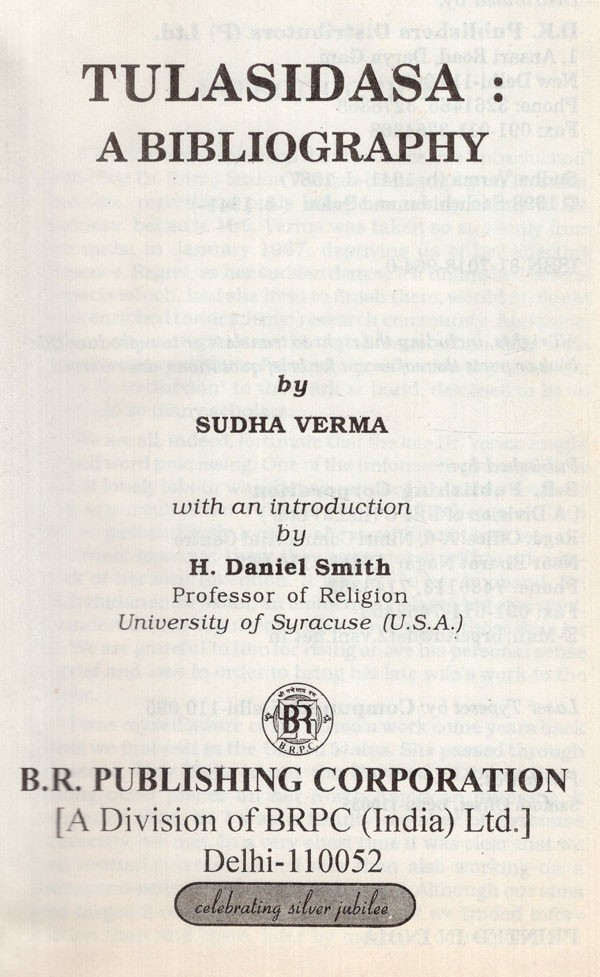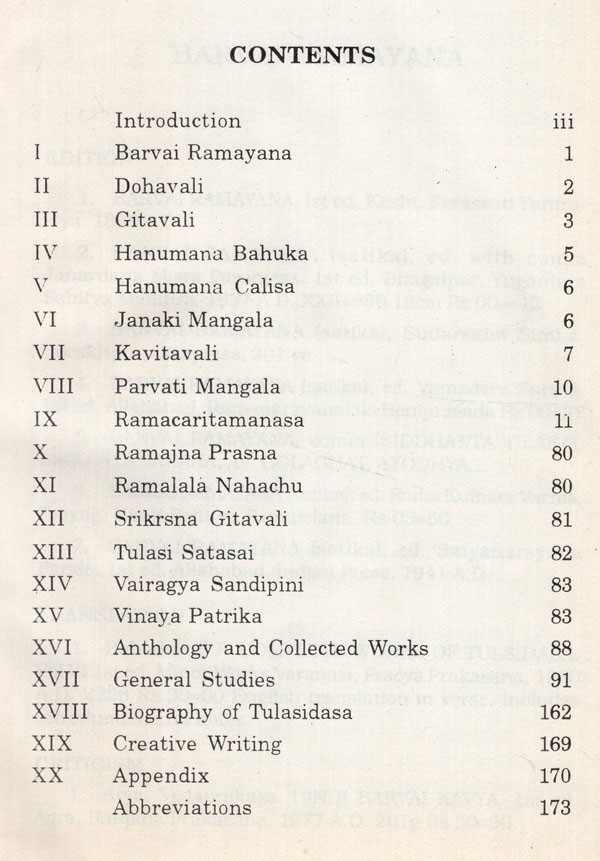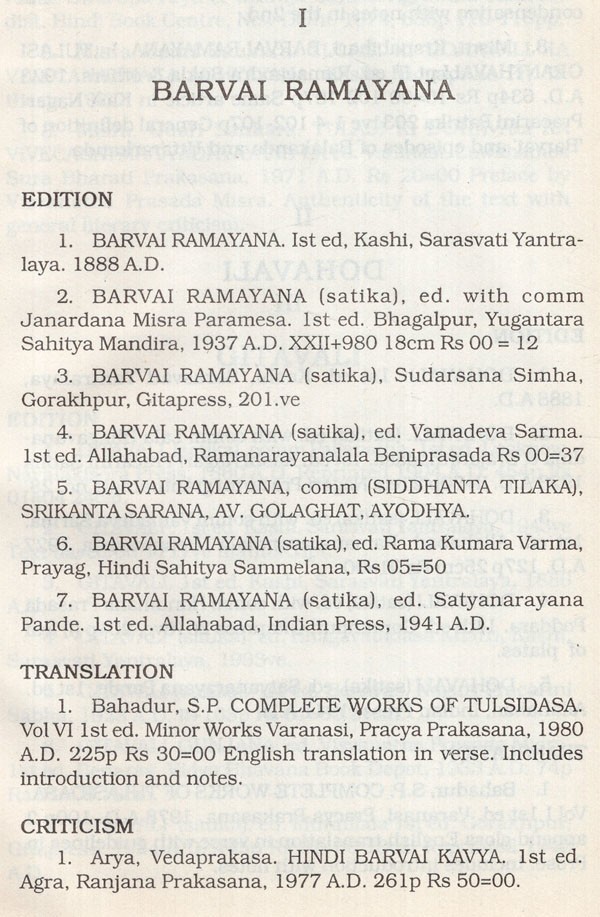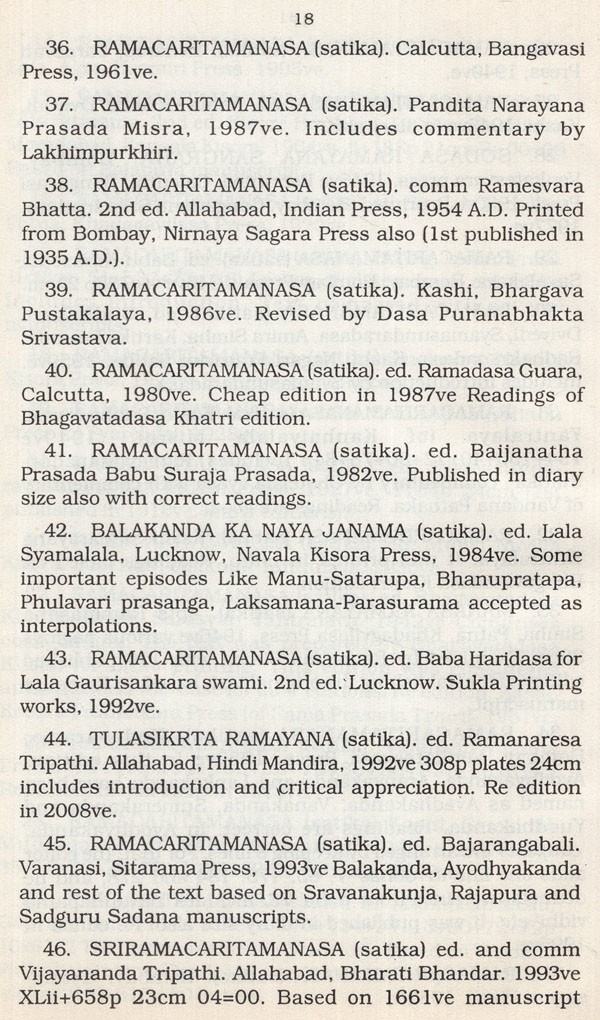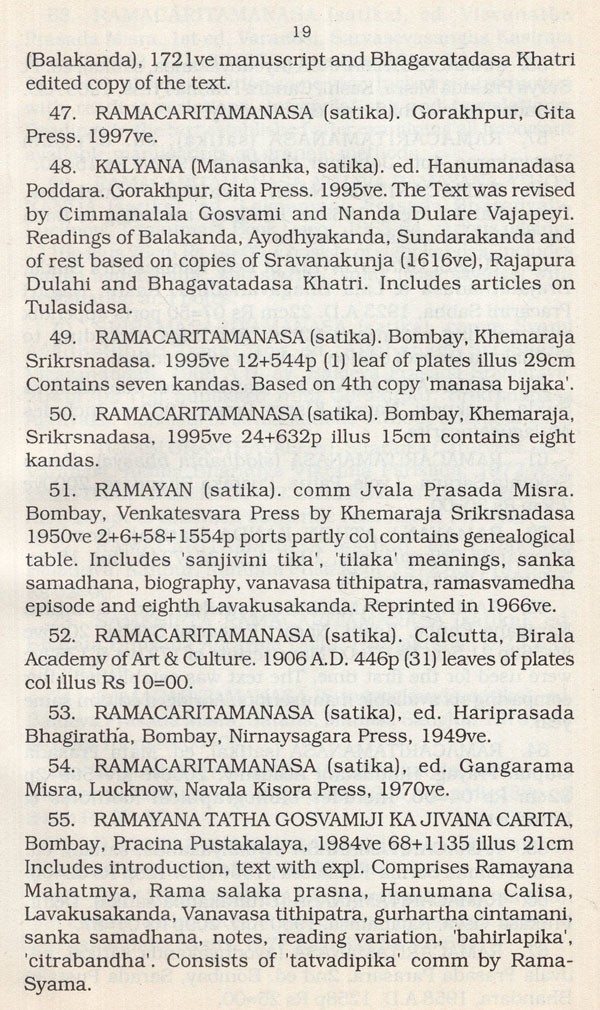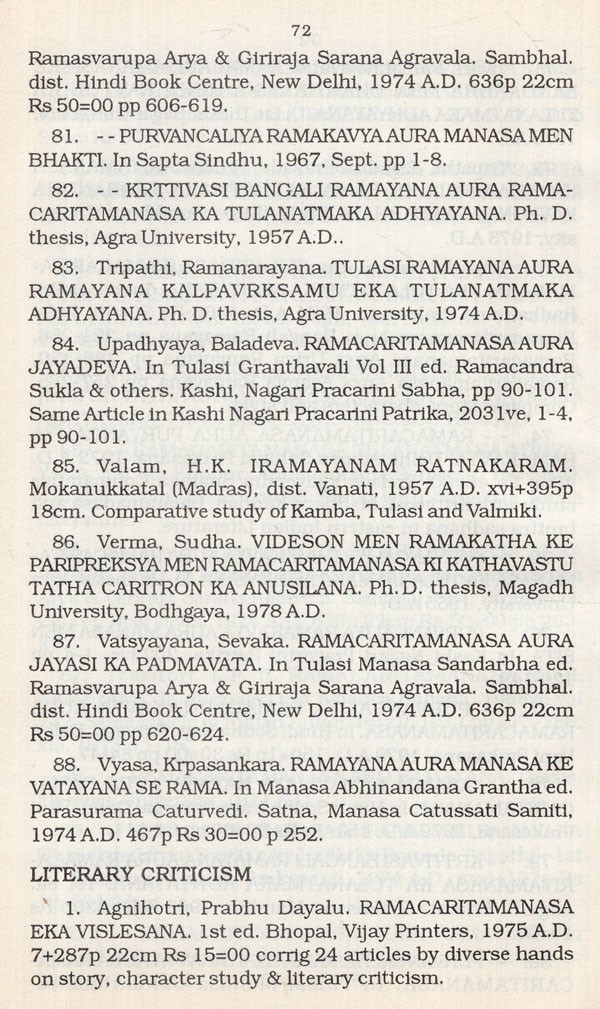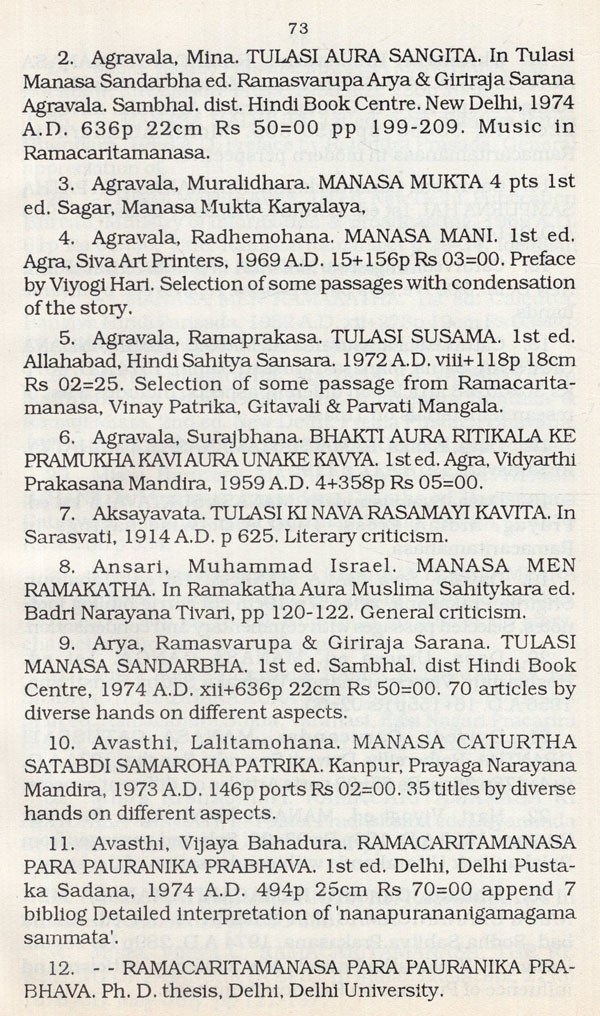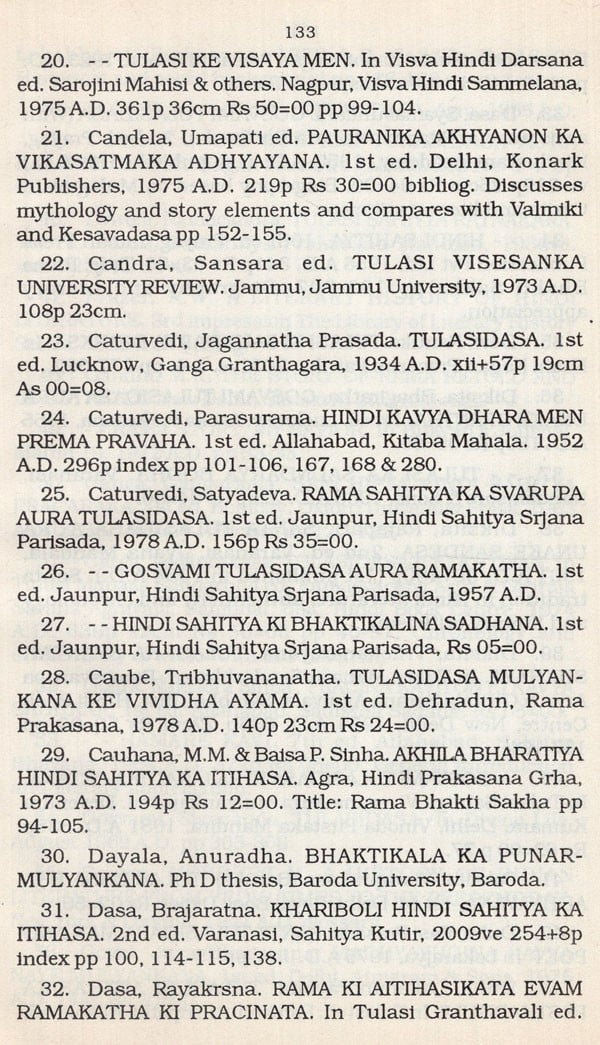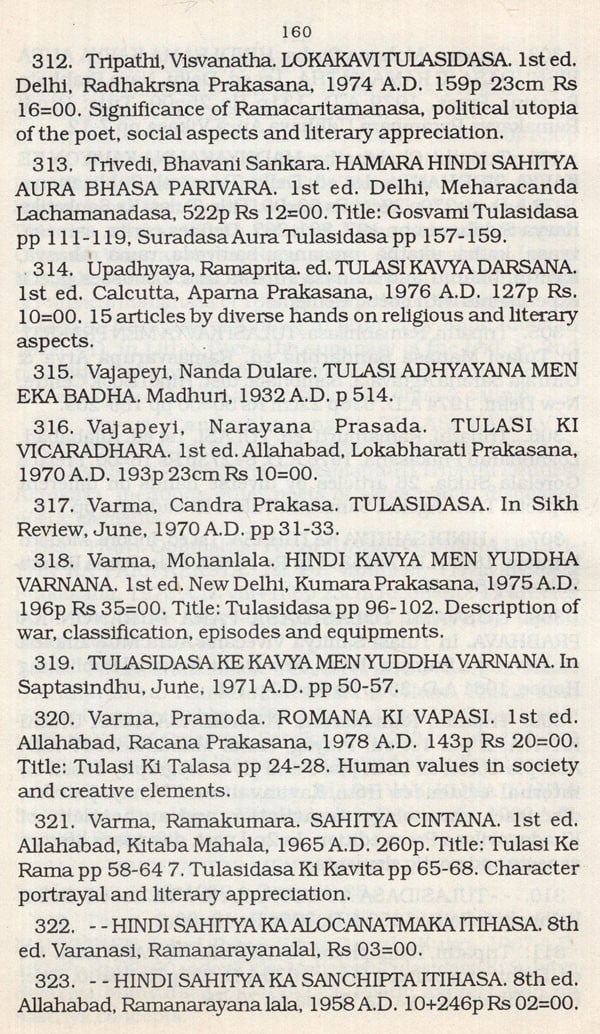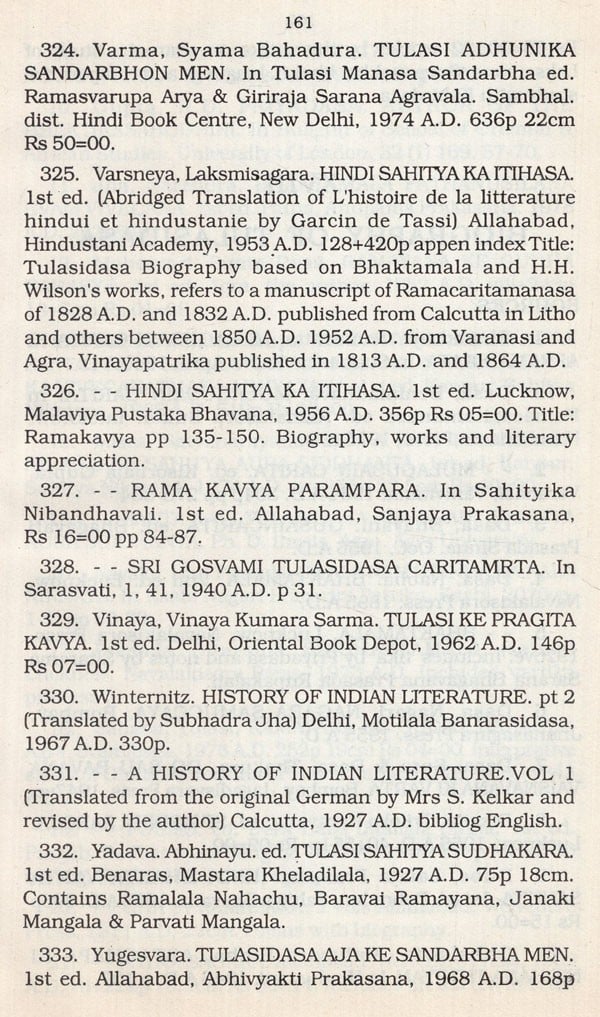
Tulasidasa- A Bibliography (An Old and Rare Book)
Book Specification
| Item Code: | UAS892 |
| Author: | Sudha Verma |
| Publisher: | 'B.R. Publishing Corporation |
| Language: | English |
| Edition: | 1998 |
| ISBN: | 8170189640 |
| Pages: | 179 |
| Cover: | HARDCOVER |
| Other Details | 9.00 X 6.00 inch |
| Weight | 340 gm |
Book Description
Tulasidasa A Bibliography offers for the first time a comprehensive, systematic and thoroughly classified corpus of research materials available on the sixteenth century Hindi poet. Containing almost 1.800 entries, the bibliography includes references to works in around twenty languages and dialects of India as well as in English (7% of the total). French, German and Russian. Divided in twenty sections, the present monograph gives separate treatment to each of the compositions attributed to Tulasidasa. In each case notice is given to editions of the text, translations (if any) and critical studies based on that particular title. Wherever available, the bibliography cites articles, chapters in anthologies, books and dissertations on matters of dating, on comparative issues, on concerns involving poetics and on similar scholarly investigations. One major section, devoted to the Ramacaritamanasa, gives critically classified listing of 700 items which are of immense interest to every student of the masterpiece. In the other major section "General Studies" one witnesses the variety of responses Tulasidasa's work has continued to elicit even in our own day.
The present work will be an indispensible tool for every reader, interested in the study of Tulasidasa in the wider perspective of world literature, offering easy access to vast number of writings in different languages and countries.
Dr. Sudha Verma (1941-1987) obtained M.A. degree in Hindi from Bhagalapur University, obtaining a first class with a gold medal for standing first in 1961 batch.
The author was awarded a Ph. D. degree from the Magadh University for a comparative study of the story elements and characters in the Ramacaritamanasa and the extra-Indian versions of the Ramayana (Videshon Men Ramakatha Ke Paripreksya Men Ramacharitamanasa Ki Kathavastu Tatha Charitron Ka Anushílana). For completing this work. the author conducted research in Laos and Thailand in 1970-71. She also obtained a two years Diploma in French from Comite de L Alliance Francaise. Vientiane, Laos.
For her published work. Agneya Asia Men Ramakatha (1982), Dr. Sudha Verma won Camille Bulcke Award from Government of Bihar in 1986 and Hanumana Mandir Trust award from Calacutta in 1985. Her other work. Manasa Ke Patra Videshi Ramakatha Ke Sandarbha Men (1987) is equally acclaimed for its deep insight in countless variations in the story of Rama.
A well-known poet. Dr. Sudha Verma began to contribute poems from her student days in 1957. Her early poems were published in Darbhanga Samachara. Jyotsana and other leading Hindi magazines of the day. Her anthology of poems entitled "Tina Dashakon Ki Antaryatra" containing a collection of 85 poems written over three decades appeared posthumously in 1990 with a foreword by Kedar Nath Singh.
For the preparation of the Tulasidasa A Bibliography the author worked as Honorary Fellow, Centre for South Asian Studies, Cornell University, Ithaca, New York (U.S.A.) in 1982.
Beginning her career as lecturer in Hindi Department in T.N.B. College. Bhagalpur in 1961, she rose to the status of Reader in the Magadh University where she taught Hindi for two decades in Gautama Buddha Mahila College, Gaya.
It is with mixed emotions that I advance this "Introduction" to the late Dr. (Mrs.) Sudha Verma's bibliography on Tulsidas. Sadness, regret and pride mingle unevenly in my heart. Sadness, because Mrs. Verma was taken so suddenly from our midst in January 1987, depriving us of her affecting presence. Regret, as her sudden demise left unfinished several projects which, had she lived to finish them, would no doubt have enriched the academic research community. And pride, Inasmuch as it gives me no small satisfaction that I am permitted to contribute even in such a humble way as author of an "Introduction" to the work at hand, destined to be so useful to so many scholars.
We are all, indeed, fortunate that the late Dr. Verma taught herself word processing. One of the unforeseen consequences of that lonely labour was that she applied her newly acquired skill in pursuit of her Tulsidas project. All references which she so painstakingly located she carefully entered into the electronic memory: there they were stored within a frame work of her own invention. It was left to her husband, Dr. Sachchidananda Sahai, an eminent scholar in his own right. to undertake the lugubrious task of retrieving those data for us. We are grateful to him for rising above his personal sense of grief and loss in order to bring his late wife's work to the public.
I was myself aware of Dr. Verma's work some years back when we first met in the United States. She passed through Syracuse, New York, to use the University Library there. among other places on her North American itinerary. It happened that, as I was a faculty member of Syracuse University, we met. In a very short time it was clear that we had mutual interests, for. I was then also working on a Ramayana-related bibliographical project. Although our aims and targeted readers were quite different we traded information then and there, later by means of correspondence between Bihar and Upstate New York. We were to meet face to face again only once more, at a seminar on the Ramayana convened during early October 1986 in Lucknow. My collecting and collating efforts resulted in two short works Reading the Ramayana: A Bibliographic Guide for Students and College Teachers-Indian Variants on the Rama-Theme in English Translations (Syracuse: Fortegn and Comparative Studies/South Asian Special Series No. 4, 1983) and Select Bibliography of Ramayana-Related Studies in English (Bombay: Ananthacharya Indological Research Institute Series No. XXI, 1989). Dr. Sudha Verma's accomplishment is the volume in hand.
On 14 October, 1995 I landed at Zia International Airport in Dhaka and that was my first encounter with Bangladesh. I came on an assignment and the pressure of settling down to an accommodation already fixed by the Indian Mission was uppermost in my mind against the backdrop of a four day non-stop hartal called by the Opposition parties from next day onwards. I got a taste of what was in store for me while coming to the city from the airport. The metre-gauge train towards Chittagong was so full that a large number of passengers were ensconced on the roofs, all on a hurried journey to their village homes with the announcement of such a long stoppage of work and violence in the air. The streets were full of processions with partisan slogans and gesticulation in a politically surcharged atmosphere.
I had no hereditary memory of the country and, therefore no sensational and nostalgic feeling which is normally the prerogative of the expatriates. However, my mind was not totally blank. I had read that my grandfather spent a few years of his hapless infancy at Dighapotia, now in Natore district way back in the seventies of the nineteenth century. A large number of the literati of the area who had regular interaction with my grandfather had migrated and there was practically no trace of them and their descendants except faint memories and stories of their deeds.
Or the temple of Lakshmi Ma at Ramrama near Taherpur. Now it is a remote village, which is not even connected by a fair weather road. Though called Lakshmi Ma temple the main deity was that of Tara. Bandyopadhyay (1931) has given an account of his chance association with this hallowed place thus:
In 1296 BS I reached the spot from Taherpur market at dusk. I was having fever and the priest was kind enough to allow me to stay for the night at the temple premises.
**Contents and Sample Pages**
